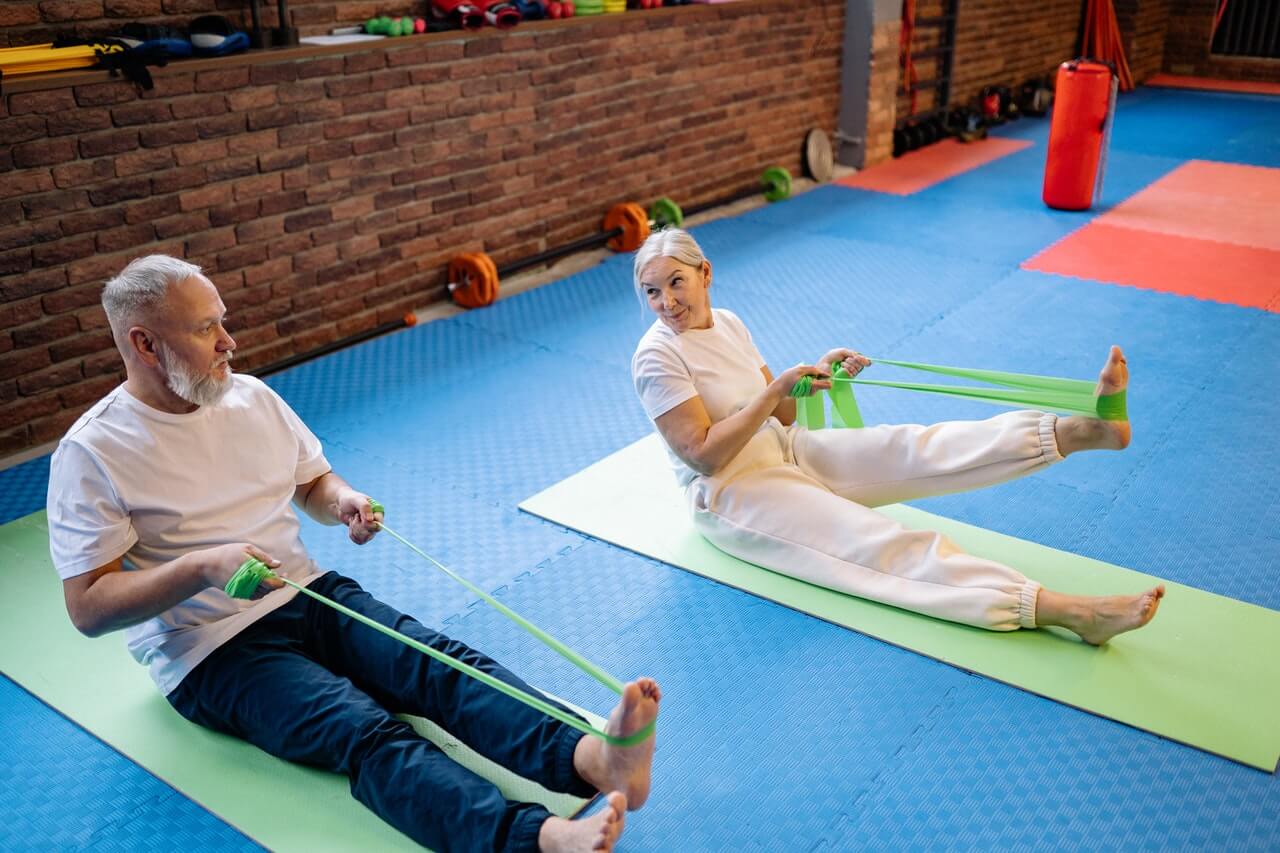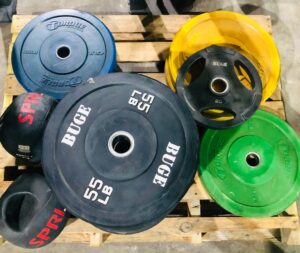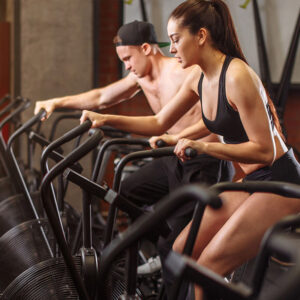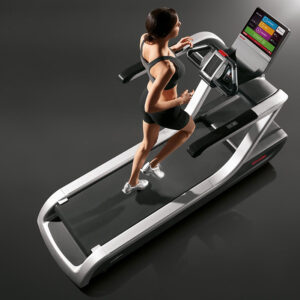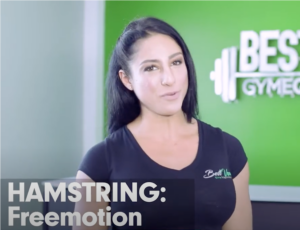As adults, we’re constantly looking for a quick fix, pill, surgery, or treatment to extend our longevity.
This is especially true as we age, and for elderly people, what might seem like an easy fix, i.e., moving less, might be more detrimental to our bodies.
The alarming thing is that research shows almost 60% of the elderly population are sedentary for at least 4 hours per day, if not more. Similarly, 67% of that figure sat down for more than 8 hours each day.
People who are 65 years and older who sit down for long periods can increase their chance of developing disabilities. They have a 54% greater risk of dying from heart disease, are quicker to experience cognitive decline, become overweight, have increased mental health problems, and more.
Arguably, health is more important than ever in this age category which is why those over 65 should be aiming to achieve the CDC’s recommendation of 150 minutes of moderate exercise each week to maintain their bodies.
There are many ways that you can easily meet this requirement through various workout routines using home exercise equipment for seniors. Many people also create their own home gyms so they can do home workouts any time.
If you’re a senior and want to know the best ways to exercise, keep reading to discover the best machines and equipment.
Why Do Seniors Need Exercise?
Yes, indeed, you might not be able to exercise as much as you used to, and you also might be worried about the risks associated with the exercises you do. The truth is there are more benefits to living a healthy and active lifestyle than the posed risks. The main benefits of exercise are:
- Manage body weight: As people get older, their metabolism starts to slow down, which means they gain weight quicker than when younger. It’s also harder to lose weight. But finding ways to do moderate exercise helps maintain muscle mass and burn calories, making it easier for people to manage their weight.
- Increase bone density and improve health: In the USA, an estimated 10 million people over 50 have osteoporosis. If you’re not familiar with osteoporosis, it’s a medical condition that causes bones to become brittle and fracture easily. Exercise helps bone tissues to adapt to the external responses exercise places on them, making them stronger.
- Help with sleep: Exercise each day raises your core temperature by a few degrees and encourages you to rest upon cool down. As a result, this encourages deeper sleep and reduces cognitive decline.
- Reduce the risk of falls: Some older people have a higher likelihood of falling over, which can have a disastrous effect on their independence. Exercise helps to build stronger bones and improve stability, so you are less likely to fall.
- Aid cardiac health: While underlying heart conditions won’t disappear due to exercise, exercise will help boost your energy and take away the strain from your heart. It also can reduce your chances of hypertension as you age. This is because a regular workout routine that includes cardio exercise makes the heart stronger and improves blood flow.
What Type of Exercise Equipment Is Best for Seniors?
If you’re a senior reading this and are unsure where to start, we understand. Going into a gym and seeing a diverse collection of machinery and equipment can be daunting. And some machines are loaded with features you may not know how to use. You should choose types of exercise machines and equipment that you enjoy using, are safe and effective, and practical. Some of the best options for seniors are:
- Rowing machines: This is a resistance-based exercise. You ‘row’ by pulling a rope toward you and strengthening your core simultaneously. One remarkable feature of rowing machines is that you can change the settings to suit your preferences. When using a rowing machine, you don’t have to strain your joints while exercising, and you can safely work out and witness steady progress regarding your strength, resistance levels, and endurance.
- Ellipticals: If you’re looking to burn a good amount of calories in a short time, an elliptical trainer might be a good option for you. Ellipticals have a combination of exercises such as walking and cross country skiing but with little impact. Using the elliptical in moderation will help improve your balance, endurance, temporarily increase your heart rate, and build muscle. What makes the elliptical great for seniors is that it features options to adjust the arm levers, speed, and incline to your liking. Plus, some have a safety mechanism designed to keep users safe and avoid injuries.
- Lat pulldown machine: Studies indicate that musculoskeletal pain such as back pain can occur in 65-85% of adults as they age. Around 36-70% suffer from lower back pain. Most of the time, this is due to bad postures or unaligned backs. The lat machine helps with back pain by focusing on upper body strength and allowing you to pull a bar in front or behind your body. You can adjust the weight according to your strength and ability in each workout.
- Recumbent exercise bikes: Cycling on exercise bikes is an excellent cardio workout activity, and using stationary exercise bikes is not strenuous. The fixed seat on the exercise bike allows you to easily climb on and off without injuring yourself. Plus, on most exercise bikes, you can change the inclines to your preference, increasing your heart rate and endurance slowly with each workout.
- Stability balls: A stability ball is one of the many items that have lots of benefits for seniors, and also those undergoing physical therapy. Even just sitting on the ball can help engage the core muscles and increase balance. Plus, you can do a range of low-impact exercises with a ball that helps increase your flexibility and balance.
Best Exercise Equipment for Seniors
1. Elliptical
The elliptical trainer is also known as a cross trainer, and it’s a stationary exercise machine. It allows you to get a great cardio workout with low impact and targets your shoulders, arms, back, chest, and lower body muscles. People use it mainly to stair climb, or improve their walking or running. The machine allows you to change the intensity of the cardio exercise for each workout to your liking by adjusting the incline.
Pros
- It contains two handles or handrails that allow you to stay stable while using it.
- Betters your balance decreasing your chances of falling
- It’s low impact and does not place pressure on the joints, reducing the risks of injury.
- It improves your cardiovascular endurance and respiratory capacity, lowering your chance of certain diseases.
- It More challenging and effective than just regular walking
- Burns calories and helps weight loss
Cons
- The walking movement is limited.
- They’re costly to own if you plan to purchase one for your home.
When to avoid using it
If you have any underlying knee or hip problems, then you should avoid using an elliptical machine. Due to the restricted movement, this machine might cause a flare-up or make them worse while using it.
2. Recumbent Exercise Bike
This is a stationary exercise bike with a chair design that allows seniors to sit down while cycling in a reclined position. Compared to other exercise bikes, on a recumbent bike, you’re sitting closer to the ground and have less strain while cycling. When using the exercise bike, you’re targetting your glutes, thighs, and calves. You can also vary the speed, intensity, and distance for workouts to suit your fitness level using the recumbent bike.
Pros
- Low-impact stationary bike workouts reduce the likelihood of an injury
- Chair design: reclined padded backrest; comfort concerns are a priority for some seniors
- Increases your cardiovascular fitness improves heart health
- Improves leg strength
- One of the most effective low-impact leg exercises
- The recumbent bike is easy to use
Cons
- Workouts on a recumbent exercise bike can become a monotonous exercise
- The bike takes up a lot of room.
When to avoid using it
If you want to work muscles in your core, you should avoid using the recumbent bike as it only targets your lower body.
3. Low-Impact Treadmill
Low-impact treadmills are exercise tools that let you walk steadily on a moving platform, usually with handrails. These treadmills offer beneficial workouts for people in old age, as the activity causes less stress on the joints than standard treadmills. In addition to this, a treadmill allows you to steadily increase your endurance, respiratory capacity, balance, and improve your cardiovascular fitness.
Pros
- Safer to use for those with musculoskeletal conditions as a treadmill places less stress on joints
- Allows you to walk on an even surface, no matter the weather condition
- Improves your balance
- Good workouts for elderly people with mobility issues
Cons
- Treadmills can become boring
- Not all the muscles are engaged in comparison to walking or running outdoors
When to avoid using it
Avoid using the low-impact treadmill if you have degenerative disc disease, arthritis, spinal stenosis, muscle strains, or herniated discs. The reason for this is that the treadmill can make the pain even worse.
4. Sitting Stepper
A sitting stepper is a portable machine that you can use to increase the mobility of your feet and legs. The machine is stationary, and the activity aids blood circulation, reduces stiffness, and lowers your risk of deep vein thrombosis.
Pros
- It can be used by people of any age, anywhere, and does not take up much room
- Using one aids circulation, and helps avoid blood clots in your legs
- One of the best options for soothing swollen ankles
- Low impact resistance training, like walking
Cons
- It can contribute to a poor posture
- Not enough resistance to burn many calories or help with weight loss
5. Free Weights
Strength training is essential for seniors as it can help keep osteoporosis at bay, and the chances of a fall. One of the best strength training options is using free weights because they work the whole body! All you need to do is pick up the weights and do strength exercises with them. For weight training using free weights, start light and gradually increase the weight.
Pros
- You can perform various weight training routines, making them practical and versatile.
- Use at home or in the gym
- Resistance increases bone mass and reduces the speed of muscle loss
- Improve mobility and flexibility at any age
Cons
- Technical skill is required, and seniors may need someone there to help them
- At home, it can be easy to get injured due to bad form
- A baseline physical strength is required to use as opposed to machine weights
6. Dumbbells
Dumbbells are free weights that are great options for resistance training certain parts of your body at any age. Also, dumbbells are good because they help improve the strength of your upper and lower body. And because dumbbells are portable, you can easily do a workout in your home.
Pros
- Improve joint health
- Control your weight
- Increase your bone density and reduce your risk of fractures
- Better balance and stability
- Greater variety of movement than with barbells
- Effective resistance training
Cons
- Higher risk of tearing your muscles
- Beginners need instructions and supervision to maintain the right technique
7. Kettlebells
Kettlebells are super effective for cardio workouts and one of the best options to burn lots of calories in short periods, making them a great piece of equipment to help achieve the 150 minutes a week goal. The rounded handle shape of a kettlebell makes it easier for seniors to grip and use while doing resistance or mobility exercises. This type of free weight is inexpensive and is great for home gyms.
Pros
- The resistance of the weight increases muscle mass
- They’re portable
- Kettlebell swings help joint issues and mobility, especially hips and arms
- A kettlebell helps with balance reducing the risk of falls
- Improves circulation throughout the whole body
- Increases cardiovascular health
- Versatile shape ideal for many different exercises
- Can provide various levels of difficulty
Cons
- Must be experienced to use; if not, you’ll need a spotter
- Requires a higher learning curve; otherwise, you’re more at risk of injuries
- They can be expensive to buy
When to avoid using it
If you have spinal stenosis, you should not use a kettlebell as it could be dangerous. Instead, consult your spinal doctor first. Also, you should avoid using one if you have a bad shoulder or experience discomfort in any part of your body while using it.
8. Wrist Weights
One of the cheapest options, wrist weights come in a handy shape that you can wrap around your wrist when working out. You can also hold them in your hands while exercising; it entirely depends on your preference! They’re light and practical to use, adding a few extra pounds of resistance, but not enough to cause strain on your wrist.
Pros
- Boosts the amount of oxygen you breathe, increasing your lung capacity
- You increase the number of calories you burn
- They tone your arms and increase your forearm strength for everyday activities
- Handy wrist position offers a great variety of exercise options
- Most come with an illustrated exercise guide
Cons
- May cause shoulder pain and joint pain in your elbows and wrists
When to avoid using it
You should avoid using wrist weights if you have rheumatoid arthritis, as it will increase inflammation in your wrists and arms.
9. Rowing Machine
The rowing machine allows you to reap the benefits of full-body exercises while rowing. A rowing machine involves you pulling on handles toward your body and extending your legs in a rowing motion. This machine allows you to sit down and choose your intensity while exercising.
Pros
- Safe way for any senior to stretch their muscles and increase flexibility
- Variable resistance level
- Rowing workouts improve cardiovascular endurance
- Increases bone mineral density for seniors
- It’s low impact, reducing your chances of injury
Cons
- Space limitations, it’s not small! More practical for a gym instead of a home workout.
- Noisy piece of workout equipment
When to avoid using it
If you have a back, hip, or knee injury, you should consult a physician or physiotherapist before using.
10. Cable Strength Machine
If you’re interested in improving your functional fitness, you might wish to try using cable machines. This stationary machine has pulleys and cables that allow any senior to lift weight in comfort. A variable weight resistance stack targets arms, legs, and back, and even legs. Cable machines provide a varied and interesting workout experience.
Pros
- Increases your strength and overall fitness
- Greater comfort for seniors than using barbells
- Suitable for all fitness levels
- Full-body fitness routine
- Safer for the elderly to use as the weights are attached to the machine
Cons
- Isolates specific body parts
- It leaves you more exhausted than other machines
- It does not allow even distribution of weight
11. Lat Pull Down Machine
A compound machine that targets the upper body and effectively builds muscle in your lats. The machine itself is stationary and low impact as users sit down while using it. Moreover, the lat pull-down machine involves pulling a bar in front or behind the body, effectively working the upper body. Furthermore, users can change the weights according to their strength.
Pros
- It helps steadily build upper body strength for seniors
- Strengthens the biceps and shoulder joints making it great equipment for seniors
- Improves shoulder girdle stability which improves shoulder health and back posture
Cons
- These fitness machines can place stress on the shoulder joint and increase the risk of rotator cuff damage.
When to avoid using it
Don’t use the lat pull down if you have tendonitis or a rotator cuff tear, as it could cause more pain.
12. Home gyms
If you have a busy schedule and can’t go to a commercial gym or want to benefit from exercise without traveling, you can always invest in a home gym. Homes gyms provide a range of strength and cardio-based fitness equipment.
Pros
- Allows senior to exercise and improve fitness any time they like
- The only limitations are space and money
- It saves time and money
- You get privacy
Cons
- You may not have the variety of activities you do at a commercial gym
- Requires a lot of space
- Need to ensure build quality
When to avoid using it
If you have a neurological condition like epilepsy, you should not use a home gym unless supervised. The last thing you want is to have a seizure and no one is there to help you.
13. Exercise Ball
Exercise balls are great soft elastic balls that you can use at home or in a commercial gym. They’re also known as stability balls in some regions. Likewise, there’s no limit to the exercise routine options with a stability ball as a range of movements can be paired with them. Most importantly, they help engage your core and improve balance.
Pros
- Improves posture for seniors
- Great for improving balance capability and flexibility
- Its simple function makes exercises and developing core strength easy
Cons
- Could increase the risk of seniors falling during exercises
- It does not provide support for the upper back
When to avoid using it
If you experience dizziness or have conditions like vertigo or labyrinthitis, you should not use this ball as it could throw you off balance. Plus, if you have a spinal disease, you should avoid doing exercises on a stability ball.
14. Balance Trainers
A balance trainer is also known as a balance board. They are a cushion that wobbles which helps strengthen your muscles and combat balance issues. This stationery piece of equipment can be used on its own for balance exercises or paired with cardio exercises. There are various balance trainers or balance boards available on the market, so you have to choose according to your weight, fitness capability, and age.
Pros
- You have to use all of your muscle groups to use the balance trainer.
- It improves your coordination and reduces your risk of falls.
- It contributes to stronger joints by stabilizing your shoulders, knees, hips, and ankles.
- It helps decrease the risk of back pain by strengthening back muscles.
Cons
- You have to balance on an unstable surface. If you’re new to using a balance trainer, you might fall.
When to avoid using it
If you already have preexisting knee or hip problems, do not use the board, as your likelihood of falling is much higher.
15. Resistance Bands
Resistance bands are elastic bands you can use to train certain body parts such as legs or arms. Resistance bands are kind of similar to free weights meaning you can do a variety of muscle-building exercises to improve muscle tone. You can also use them to do a variety of flexibility exercises. When used with a bench, it’s even possible to replicate a traditional bench press using resistance bands.
Pros
- Resistance bands are portable, and you can use them anywhere
- They’re affordable for seniors
- Resistance bands provide less compression on the joints than free weights
- They engage your core muscles, therefore, contributing to better balance and stability.
Cons
- It takes knowledge and a certain level of skill to work muscles effectively with resistance bands.
- Restrictions according to the intensity of each resistance band.
16. Step Benches
A step bench is an elevated bench or platform that allows seniors to perform aerobics or exercises involving a step. The equipment for seniors comes with different heights, which you can change according to your scope of movement.
Pros
- It targets your core, leg muscles, and upper body, contributing to better balance and flexibility.
- Frequently practicing with the step bench reduces your risk of falls
- It improves coordination for adults
- Burns calories
Cons
- It can place a lot of pressure on the knees, hips, and back
When to avoid using it
For adults who have arthritis, it may be painful for you to use a step bench, and if you do use it, you might require a chair for extra balance.
17. Ab Machines
An ab machine is a piece of exercise equipment or machine that targets the abdominal muscle groups. Common examples of ab machines are rollers, ab workout benches, ab stimulators, and ab trainers. Ab machines are highly effective for seniors as they are low impact and burn calories simultaneously.
Pros
- They engage the core and help improve balance
- Contributes to a stronger core for seniors
- Burns calories
Cons
- It can cause pain in your lumbar spine
When to avoid using it
If you have back pain, you should avoid using it as this could make it worse.
18. Stretch machines
Stretch machines are a steady way you can perform various stretches for certain areas of your body. Usually, a machine will have a manual or electric wheel that you rotate to stretch certain areas of your body. Stretch machines are great for seniors as they can loosen their limbs before and after a workout.
Pros
- It can help improve your bearing
- Increases your flexibility
- The machine can reduce the risk of injury
- Better performance
- Increased circulation
Cons
- If done incorrectly, it can cause muscle tears in the tissue and trauma for seniors.
19. Foam Roller
A cylindrical tube that’s lightweight and made of compressed foam. The foam roller is for relieving soreness, increasing flexibility, removing muscle knots, and more. They’re incredibly affordable exercise equipment, lightweight, and easy to carry around. A foam roller can be used before, during, and after exercise.
Pros
- Increases range of motion in joints of seniors
- Low impact exercise
- Improves flexibility
Cons
- They’re widely available, but quality can vary.
When to avoid using it
You should not use a foam roller if you have advanced diabetes mellitus, varicose veins, osteoporosis, or lymphedema.
20. Yoga Mat
A yoga mat is a simple, inexpensive, and effective piece of equipment for seniors. You can perform a range of low-impact exercises on your knees, arms, and legs from the floor. Yoga mats are common for doing pilates, yoga, and core exercises.
Pros
- They help strengthen the core and improve balance
- It is not expensive
- It can be used anywhere and is a great home exercise equipment
Cons
- Some are thin and can break easily
21. Hand Gripper
A hand gripper is great exercise equipment for seniors that helps build up strength within the hands and fingers. They’re fantastic for seniors as they help increase their dexterity. The equipment has two handles you place in one hand and squeeze together. When you work the hand muscles like this it helps strengthen your grip; a feature that is super useful every day!
Pros
- Develop a higher threshold to resistance and pain
- Strengthens muscles in your hands, fingers, and forearms
Cons
- It may not be ideal if you suffer from wrist pain
How to Choose the Best Exercise Equipment?
If you’re looking to buy some workout equipment for seniors or the best exercise equipment for home use, there are some factors you should consider before buying, which are:
1. Your goals
You don’t want to go and buy any random gym equipment or fitness equipment. It’s essential to think about your specific fitness goals, whether to work out to aid flexibility, better your balance, improve your bearing, or other goals. Similarly, consider the area of your body you’d like to work on and then look at the equipment options that will support your goals. Plus, buying the right types of exercise equipment for seniors that helps support a specific goal will help maintain your motivation.
2. Consider your health and consult with your doctor
It’s always a good idea to go for a health check-up with your doctor or primary care provider before undergoing any rigorous or new exercise. If you start a new exercised regime, there is a slightly increased risk of cardiac complications or a heart attack. A doctor will look at your health history and advise you accordingly on the best exercise equipment for seniors.
3. Choose an activity that you like
Exercise has a range of benefits as long as you do it frequently and consistently. Ideally, you want to stick to exercises you like and that won’t bore you. You don’t want to pick something that’s trending and short-lived, as it’s not sustainable in the long run.
4. Consider your budget
You must exercise within your financial means. Think about your budget and then look at the home exercise equipment you can buy within that price range. You don’t need to spend a fortune to feel the difference regular exercise makes in your life. As an alternative way to access exercise equipment for seniors, you could invest in a gym membership.
Conclusion
Fitness equipment and exercise equipment for seniors can reduce the chances of falls, cognitive decline, aid sleep, improve mental health, increase bone density, muscle mass, and much more. There’s so much scientific research to support exercise for the older generation and different types of exercise equipment for seniors.
All it takes is to exercise moderately for 150 minutes each week to start noticing and feeling the changes. But, you don’t want to do just any exercise; you must consult with your doctor first and choose exercise equipment that aligns with your ability, fitness goals, and budget.
Elderly people who haven’t been active for a long time might like to start with some simple chair exercises, or use a chair as support while balancing, and build up their mobility and fitness from there. Safety should always be a priority!
FAQs
Is a treadmill or elliptical better for seniors?
If you’re a senior, you might be wondering which is the best exercise equipment for seniors. First of all, the treadmill focuses on speed and incline, helping your running, walking, and cardiovascular endurance.
However, it can cause a lot of pressure on your knees, ankles, and hip joints. For these reasons, as an alternative, the elliptical trainer tends to be better cardio equipment, as it is a low-impact machine and targets the whole body. It also works forward and backward allowing you to engage more muscles.


